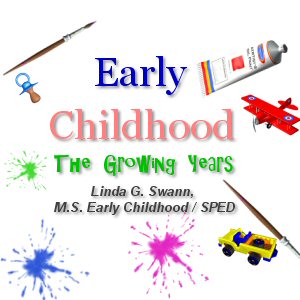More On Cognitive Growth
 Continuing with predictable child development in the six domains (gross motor, fine motor, cognitive, language, self help/adaptive, and social/emotional), we continue with cognitive skill development. Another way to encourage cognitive development is through creative art. This is a great way to expand your child’s cognitive ability. Creative art in the adult world, can be pieces of perfection and are judged on technique, but not in your child’s world. In fact it is just the opposite. Children should be given no boundaries, and a large variety of materials. Do not expect your child to stay in the lines, this will come when fine motor skills are ready. Allow complete artistic freedom, not judging the art, but instead talk to your child about the beautiful art piece he/she has created. It is important to encourage your child to talk about the picture or object, and be aware that he/she knows exactly what it is, even if you do not have a clue. Resist expressing to your child that you do not know what is in the picture. Instead, say things like, “Oh how beautiful, can you tell me about it”? If you hear that it is a tree, and you just do not see it, simply say, “Wow, that’s a great tree”. Remember your child’s imagination is at work and cognitive growth is taking place.
Continuing with predictable child development in the six domains (gross motor, fine motor, cognitive, language, self help/adaptive, and social/emotional), we continue with cognitive skill development. Another way to encourage cognitive development is through creative art. This is a great way to expand your child’s cognitive ability. Creative art in the adult world, can be pieces of perfection and are judged on technique, but not in your child’s world. In fact it is just the opposite. Children should be given no boundaries, and a large variety of materials. Do not expect your child to stay in the lines, this will come when fine motor skills are ready. Allow complete artistic freedom, not judging the art, but instead talk to your child about the beautiful art piece he/she has created. It is important to encourage your child to talk about the picture or object, and be aware that he/she knows exactly what it is, even if you do not have a clue. Resist expressing to your child that you do not know what is in the picture. Instead, say things like, “Oh how beautiful, can you tell me about it”? If you hear that it is a tree, and you just do not see it, simply say, “Wow, that’s a great tree”. Remember your child’s imagination is at work and cognitive growth is taking place.
Creative art helps develop cognitive skills through problem solving! Deciding what line to draw, what color to use, what the tree should look like, should there be animals, what will they do. The list of choices is extensive, thus the brain is exercised, and ideas are created. Thoughts are linked to create more ideas. Who knows, your child may be inventing a new “wonder gadget”, after all, your child is inventing. The neurons are firing making creative art a means to greater cognitive growth.
Keep art supplies in a plastic tub. Some things can be found in the trash and outside in the yard. You will need crayons, children’s scissors, glue, finger paints and paints with brushes, colored, white, and tissue paper and chalk. Add anything textural, like sponges to use for painting. Collect q-tips, clothes pens, cotton balls, medicine droppers, straws, tape, hole punches, old buttons, thread, ribbon and yarn. Packaging materials offer opportunities for creativity (problem solving), along with pasta of all kinds. Supplies are only limited by your imagination, and remember, your junk is a child’s treasure. Art does not always have to be on paper. Give your child a paper cup, some cotton balls, toothpicks and other items found around the house, and let your child use his/her imagination to create monsters, machine, cars or whatever the brain desires.
Yes, art is a great way to develop cognitive skills. Not perfect art, but creative art. Art that is his/hers. Art that your child owns. Make the activity even better by sitting with your child and creating an art piece of your own.












